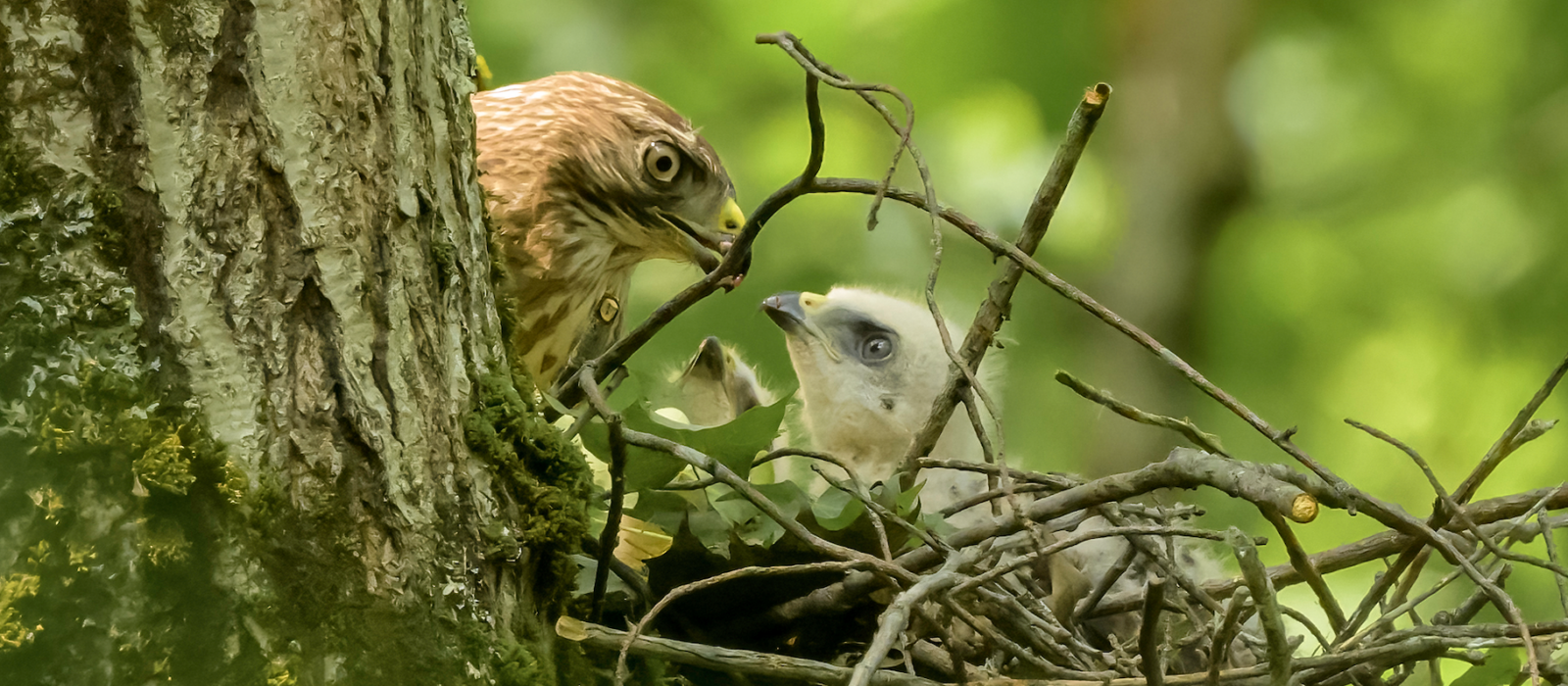Broad-winged Hawk Monitoring
After three seasons of monitoring this common but secretive, woodland breeding raptor, Harris Center staff located and monitored six Broad-winged Hawk nests in Dublin, Hancock, and Jaffrey in 2023. Two previously-tagged adult females, ‘Skatutakee’ and ‘Nubanusit,’ returned to nest in their same territories from the prior year after spending the past winter in Bolivia and Colombia, respectively. We know this thanks to the transmitters researchers from Hawk Mountain Sanctuary deployed, which have provided us with a better understanding of pre-migration and migration movements, as well as how they navigated their less-known wintering grounds.
A fuzzy broadwing nestling. (photo © Chuck Carlson)
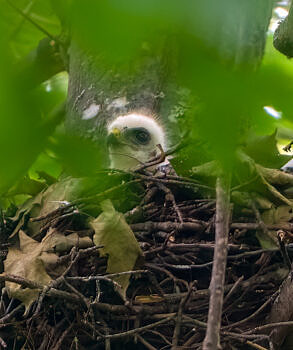
Still on the nest, but steadily growing! (photo © Chuck Carlson)
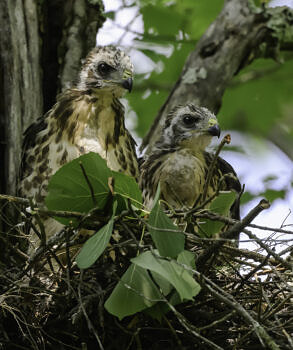
A juvenile broadwing moves away from the nest. (photo © Chuck Carlson)
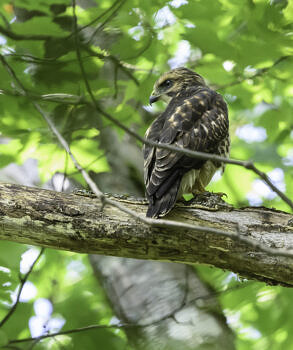

This map shows Skatutakee’s pre-migratory flight northward.
(map © Hawk Mountain)
Monitoring the territories during the breeding season yielded a mixed bag, and broods were low this season, comprised of one to two nestlings (as opposed to the usual two to three) — perhaps owing to the down year for small rodents, a primary food source. Harris Center Bird Conservation Director Phil Brown and volunteers Tom Momeyer and Chuck Carlson continued to monitor and photo-document the nests to fledging, which occurred for most birds during the last part of July.
Skatutakee, who nested on Dublin School property, appeared to lose her nestlings during late July, perhaps coinciding with the tornado that tore through the campus. Her transmitter began to signal shortly thereafter as she made a northbound ‘pre-migratory flight,’ which appears to be typical of breeding females of this population. Nubanusit’s nest fared better, fledging two young on Harris Center land near Willard Pond in Hancock. As summer wanes, fledglings will learn to hunt on their own, and in a month will be faced with a long migration to central and South America. Stay tuned to Hawk Mountain’s migration maps, which will go live again as the birds begin their southbound journeys next month!
American Kestrel Nest Box Monitoring
In 2022, the Harris Center launched a new nest box project focused on the declining American Kestrel. The project began modestly with three nest boxes in an attempt to learn more about local kestrel populations. We ramped up efforts in January 2023 to fundraise for and purchase materials associated with additional nest boxes and poles.
During the spring of 2023, our staff, interns, and volunteers built 21 nest boxes and placed them in high-priority open field landscapes across a dozen towns in the Monadnock Region, guided in part by past intern Will Stollsteimer’s habitat suitability model. We were thrilled to confirm that four nest boxes were occupied and, ultimately, fledged full broods of young by early August. As a result of these efforts, 17 new kestrels have entered into the world. The Harris Center was fortunate to have the assistance of New Hampshire’s longtime kestrel expert, Steve Wheeler, who lent his time and expertise to the project, sharing tips on nest box construction, placement, and even banding all 17 chicks.
Phil Brown holds a squawking, fuzzy kestrel nestling. (photo © Brett Amy Thelen)

A kestrel sits in a nest box, surrounded by her chicks. (photo © Phil Brown)
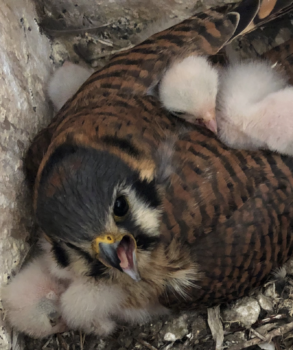
The lessons learned throughout this first full year of nest box monitoring have been invaluable and will shape the future of this project. Though just 17% of boxes were occupied, there is still much room to expand the population. In the off-season, we’ll be refining our criteria for nest box placement, reaching out to more landowners in priority landscapes, and investigating ways to better track individual birds in coming years. Despite what we already know about kestrel populations both locally and further afield, there are still many questions about factors surrounding their survival, food sources, and migratory journeys. Answering some of these questions may ultimately help to reverse their long-term population declines and make this charismatic and colorful falcon a common sight again.
The Hawk Watch Returns to Pack Monadnock
The 19th consecutive season of fall monitoring of migratory raptors is soon to be underway at Pack Monadnock Raptor Observatory at Miller State Park. We welcome back seasoned raptor biologists, Levi Burford and Katrina Fenton, who along with a team of volunteers, will staff the Observatory daily (barring poor weather days) from September 1 through November 20. ‘Pack’ is a fantastic place to witness the spectacle of fall raptor migration, where American Kestrels sail by and Broad-winged Hawks gather by the hundreds in mid to late September. October and November are also excellent months to witness some of the dozen other raptor species – eagles, falcons, and hawks – that migrate past the Observatory.
Last season saw 12,370 migrant raptors pass the Hawk Watch in more than 550 hours of observation time, and we welcomed 6,076 visitors, including hundreds of students who learned about migration, identification, and raptor conservation efforts. The Harris Center’s long-term commitment to standardized migration monitoring at the Observatory has produced an increasingly valuable dataset that researchers use to estimate global raptor populations. We hope to see you on the mountain again this fall!

A group of birders scan the skies for migrating hawks at the Pack Monadnock Raptor Observatory. (photo © Susie Spikol)
To learn more about the upcoming migration, join us for a Zoom talk by Phil Brown, Migratory Raptors of Pack Monadock, on Thursday, September 14. If you’d like to join a scheduled event at the Observatory, feel welcome to attend the World Migratory Bird Day Big Sit at Pack Monadnock on Saturday, October 7.
For more information about visiting the Observatory, including how to make park reservations, and when to visit, see our Pack Monadnock Raptor Observatory page.
Contact Us
For more information, please contact Bird Conservation Director Phil Brown at (603) 525-3394 or by email.
